 |
|
 |
|
updated to follow: Stratigraphic Guide to the Cromer Knoll, Shetland and Chalk Groups of the North Sea and Norwegian Sea. Felix M. Gradstein & Colin C. Waters (editors), Mike Charnock, Dirk Munsterman, Michelle Hollerbach, Harald Brunstad, Øyvind Hammer & Luis Vergara (contributors). Newsletter on Stratigraphy, vol 49/1 pp71-280, 2016
Shetland Group, Blålange Formation
English/ Norwegian and any previous names:
The name "Lysing Formation" was introduced by Dalland et al. (1988) as the only sandstone unit recognised in the Norwegian Sea area at that time, the other formations being dominated by mudstones. This study reduces the unit to member status within the Blålange Formation, on the basis of being detached sandstone bodies, and for consistency with other new sandstone members recognised in the area. It is also reassigned to the Shetland Group (formerly Cromer Knoll Group of Dalland et al., 1988) following the revised group definitions in the Norwegian Sea area.
Derivatio nominis: The name Lysing is derived from the Norwegian word for the fish species Merluccius merluccius or hake.
The Lysing Member consists predominantly of clear to white-grey or grey-greenish quartzitic sandstones with subordinate interbedded mudstones. The sandstone grain size is fine to medium or occasionally coarse, with moderately sorted sub-angular to sub-rounded grains, occasionally sub-spherical. The sandstones are frequently glauconitic (imparting the grey-green colouration), or have traces of mica and are calcite cemented. The mudstones are medium dark grey, firm to hard, weakly laminated, sub-fissile, micro-micaceous and non- to slightly calcareous, with traces of fine crystalline pyrite and mica. In cores of the reference well 6506/12-4, the sandstones form thick 0.3 to 1.5 m beds, or thin sandstone laminae within the subordinate interbedded mudstones.
The member is widely distributed on the Halten and Dønna Terraces, particularly along the margin of the Nordland Ridge. It is generally thin (< 5 m) e.g. in wells 6507/2-1 and 6507/5-5, and absent on the Trøndelag Platform.
It is also variably developed in wells that have penetrated the deeper parts of the Vøring Basin e.g. 6605/8-1 (Stetind), but was not present in the 6504/5-1 well (Gemini prospect) that was also drilled in the Vigrid syncline (Heskestad et al. 2009). In this well, the time-equivalent section was represented by mainly mudstones with thin sandstones, siltstone and limestone stringers. Maximum thicknesses of over 100 m (gross) are on the westerly flank of the Halten Terrace in block 6506/11 (Morvin Field) e.g. 6506/11-4 S (120 m) and 6506/11-7 (111 m).
Reference well 6506/12-4: 15 slides, of which 14 are core samples and 1 ditch cuttings sample, covering the interval 3129.1 m - 3144.3 m are available at the NPD. Note that these fall in the (+5.9 m) corrected core range of the member.
Reference well 6506/12-4: core #1, interval 3129 m - 3150 m (3142.9 m uncorrected core depth). Note there is at least a +5.9 m core correction to this core.
Reference well 6506/3-1 (new additional reference well): core #1 3101.5 m - 3171.5 m (uncorrected core depth). The lowermost part of the member is cored including the base of the member at 3109.41 m (uncorrected core depth). Note that core #1 has a +1.07 m core to log correction.
6506/12-4:
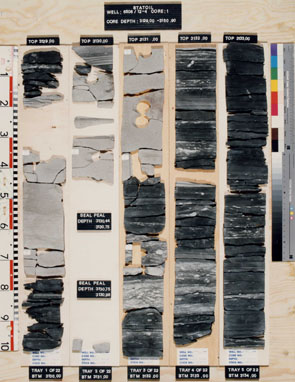 6506/12-4, 3129-3133 m |
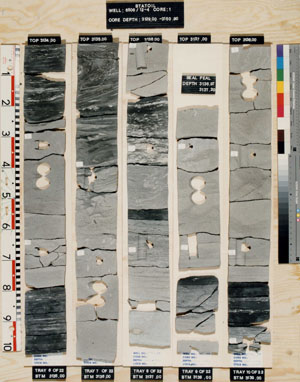 6506/12-4, 3134-3138 m |
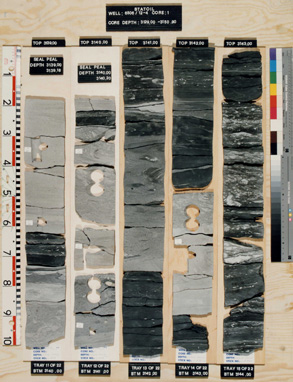 6506/12-4, 3139-3143 m |
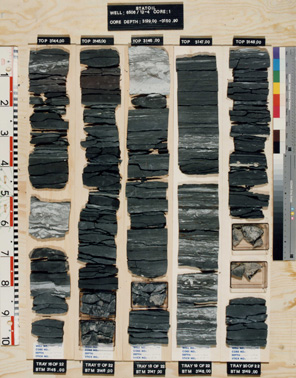 6506/12-4, 3144-3148 m |
6506/3-1 (selected core details only):
WGS84 coordinates: N 65°27'16.7", E 07°12'52.6"
UTM coordinates: 7260481.16 N 417247.40 E
UTM zone: 32
Drilling operator name: Conoco Norway
Completion date: 01.12.1984
Status: P & A
Interval of type section (m) & thickness in type well:
3000 m - 2926 m, 74 m thickness.
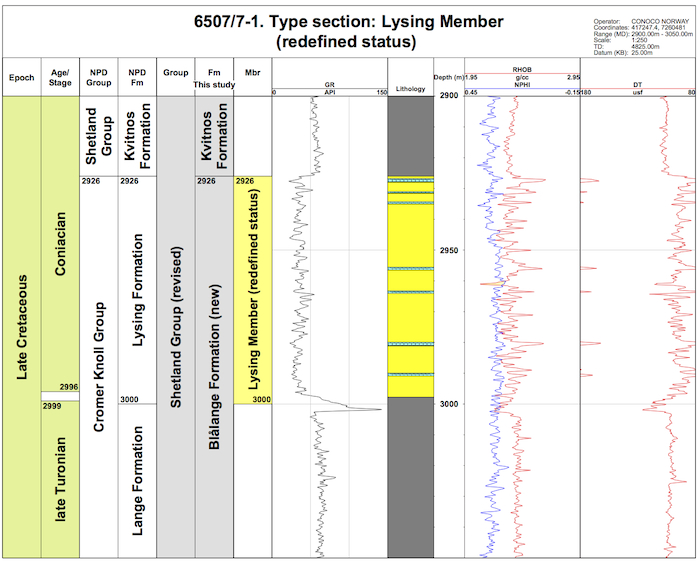
WGS84 coordinates: N 65°12'46.97"N, E 06°43'30.37"
UTM coordinates: 7234298.14 N 393591.29 E
UTM zone: 32
Drilling operator name: Den norske stats oljeselskap a.s. (Statoil AS)
Completion date: 13.08.1985
Status: P & A
Interval of type section (m) & thickness in type well:
3150 m to 3132.5 m, 17.5m thickness. The lower 15 m of the formation are cored,
including the base
at 3142.87 m MD RKB (uncorrected core depth). Note core #1 has a +6.9 m core to log
correction.
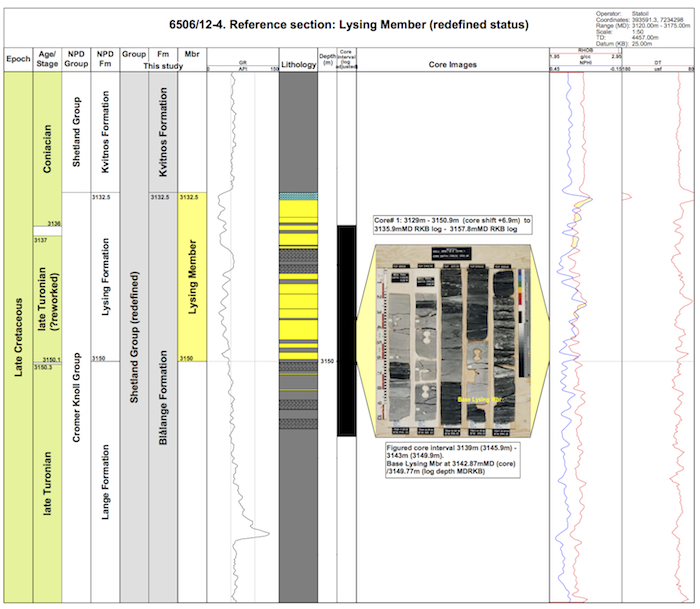
It was considered appropriate to define an additional reference well 6506/3-1 in order to see the log variation within the Lysing Member.
Well name: 6506/3-1
WGS84 coordinates: N 65°48'20.75"N, E 06°44'32.64"
UTM coordinates: 7200300.07 N 396769.02 E
UTM zone: 32
Drilling operator name:Norsk Chevron AS
Completion date: 9.08.2001
Status: P & A
Interval of type section (m) & thickness in type well:
3110.5 m MD RKB (3109.41 m uncorrected core depth) - 3090 m MD RKB, 20.5 m
thickness.
In the type well 6507/7-1, the basal stratotype is defined by a gradual decrease in the gamma-ray log, and an upward increase in sonic velocities response at the onset of a more serrate pattern on the resistivity and sonic logs. In other wells, e.g. 6506/6-1, 3080 m MD RKB, the base of the member may be sharp and reflects the abrupt input of sandstones. In some instances, the base of the Lysing Member has been defined at a prominent high gamma marker (informal sequence k58a) within the upper part of the Blålange Formation e.g. 6506/12-10 (6580 m MDRKB). However, the position of this regional correlative event may be as much as 30 m below the first development of sandstones and is not recommended, e.g. 6506/3-1 (3110.5 m MD RKB). In the type well 6507/7-1 the informal k58a marker is almost coincident with the base of the Lysing Member, presumably due to local erosion at the base of the unit. However, this useful marker, which may represent a synchronous ash bed, provides a means of distinguishing Lysing Member sandstones from older sandstones of the underlying Blålange Formation based only on wireline log information.
The wireline log response of the Lysing Member is variable. In the type well 6507/7-1, the member is characterised by a serrate but generally blocky gamma-ray profile with a funnel shaped basal section. Dalland et al. (1988) in their original description also noted that the resistivity and sonic log patterns were generally serrate with respect to the underlying and overlying intervals, but these probably relate to zones of calcite cementation within the sandstones or thin limestone stringers. In the reference well 6506/12-4, however, the Lysing Member has a generally irregular gamma-ray log profile and in the 6506/3-1 well, a lower irregular unit is divided from an upper, funnel shaped, cleaning upward unit by a unit of mudstones . This variation in log profile reflects local differences in the depositional style of the member.
A prominent high gamma ray feature (informal k58a event) e.g. 6507/7-1 (3002 m MD RKB) provides a useful and regionally correlatable event below the member
In the type well 6507/7-1, the Lysing Member is late(st) Turonian through Coniacian in age, with the late Turonian dinocyst marker LO Stephodinium coronatum occurring 2 m above the base of the member in sidewall samples at 2998 m. In the type well, there is an increase in Heterosphaeridium difficile at the same level, although the lack of separation of these two events may suggest some minor (local) erosion at the base of the member.
The FO Chatangiella 'spinosa' appears to be within the middle part of this member and suggests an age no older than Coniacian, e.g. 6507/7-1, 2964.5 m swc. The Lysing Member is generally within the abundance ranges of the Palaeoperidinium pyrophorum and Palaeohystrichophora infusorioides palynoevents that are regionally typical of the early Coniacian.
Planktonic foraminifera are generally absent in the Lysing Member, but pyritised diatoms such as Stellarima spp. and radiolarians (cenosphaerid and spumellarian types) are frequent, particularly towards the base.
In the reference well 6506/12-4, dating is problematic, since many Triassic palynomorphs are present. This indicates a Triassic origin of the sands during Coniacian time. It is uncertain whether the sporadic occurrences of S. coronatum throughout the member are in situ or reworked.
More meaningful biostratigraphic data are derived from the additional reference well 6506/3-1 where LO S. coronatum occurs in mudstones immediately below the member (3111.04 m corrected core). The increase in H. difficile (from 3100 m dc and extending within the lower cored interval of the member to 3108.98 m corrected core) suggests that in this well, the Lysing Member straddles the Turonian-Coniacian boundary.
Additional dinocyst events that assist correlating the Lysing sandstones are the LO of Psaligonyaulax deflandrei, LO Spiniferites porosus and acme C. 'spinosa' in the overlying Kvitnos mudstones and the LO of Cyclonephelium membraniphorum either within or below the member.
In summary, the Lysing Member in a majority of wells is assigned an early Coniacian age. Some sandstones developed within the lower part of the member may be late Turonian in age.
The main sandstones of the Lysing Member are usually early Coniacian age but the member may straddle the Turonian/Coniacian stage boundary in some wells. In some instances, the biostratigraphic dating is complicated by syn-sedimentary reworking. This review suggests a considerable reduction in the age uncertainty than presented earlier by Dalland et al. (1988).
When Dalland et al. (1988) first formally described the unit there was considerable uncertainty on the depositional processes and setting of these sandstones. Interpretations varied from shallow to deep marine and possibly sandstone dominated fan lobe deposits as suggested for the type well 6507/7-1 by Hastings (1987) and Vergara et al. (2001). Since that time, there have been several more publications on the depositional setting of the Lysing sandstones from most areas of the Norwegian Sea.
This review of the current literature suggests deposition in a variety of settings on the upper slope, lower slope and basin floor. Significantly, there are no interpretations that support an in situ shallow marine, tidal interpretation in spite of the development of a sedimentary facies in core e.g. 6506/12-5 that is characterised by cross stratified, glauconitic sandstones. These have interpreted as being a slumped unit of tidal sediments (Shanmugan et al., 1994) that may be related to the slumping identified by seismic facies mapping in the southern Halten Terrace south of Quadrant 6406 (Vergara et al., 2001), or atypical in situ deep marine sediments emplaced by episodic bottom traction currents (oceanic contourites) in a deep, basin floor setting (Hastings 1986; Walker 1998 unpubl.). Significantly, in their argument to support slumping and mass transport complexes, Vergara et al. (2001) undertook backstripping of sections across the Halten Terrace to indicate paleo-water depths of several hundred metres during their K80 (Lysing time) sequence. Although not a period of tectonic activity, Lien (2005) in his development of the Cretaceous to Eocene deep-water hydrocarbon reservoirs of the Norwegian Sea recognised that the Lysing (Sequence K60) was part of the late post-rift phase representing a time of passive infill, high subsidence rates and subsequent sediment loading in the basin causing basin margin uplift and tilting.
Gradstein et al. (1999) studied the micropaleontology of the Lysing Member interval for the purpose of paleobathymetry. Sparse planktonic foraminifers indicate normal salinity, open marine conditions. A poor benthic foraminiferal assemblage with few calcareous taxa including Dentalina, Gyroidinoides, Pleurostomella., and few coarse agglutinated ones like Bathysiphon, Psammosphaera, Trochammina and Ammodiscus may reflect restricted bottom conditions in a deep neritic or bathyal setting. Small pillbox diatoms are common, and pyritized, pyritized radiolarians occur rarely, but also testify to normal marine salinity, and bathyal conditions. A high sedimentation rate under restricted bottom conditions, together with some sorting, and diagenetic loss of taxa due to dissolution, probably combined to yield the ‘impoverished’ microfossil assemblage.
Of interest is that several levels in wells, poor in microfossils, give the impression being sorted hydrodynamically, with a prevalence of spherical, tubular or disk-shaped forms, including Psammosphaera, Bathysiphon, Ammodiscus, and sideritic and pyritic concretions that maybe tiny burrows. The environment of deposition probably was largely dysaerobic, semi-restricted, and of high energy due to turbidite scouring, and on average unfavourable to a diversified benthic life. A bathyal setting is most likely, in agreement with the fairly common presence of tubular agglutinated taxa, like Bathysiphon. In discussion with W. Kuhnt and T. Sæther (pers. comm., 1996), the possibility was raised that such a benthic foraminiferal assemblage might represent overbank deposits at bathyal depth, to the side of a mass-flow sand conduit. Where sands were sampled, presumably in these conduits, no foraminiferal assemblage was recovered, also no shallow marine taxa that could be considered transported down slope.
Another scenario is that common Psammosphaera, found as dominant taxon in many Lysing Member samples, was an early seafloor colonizer after a mass-mortality event, reflecting a disturbed environment, due to repeated sand scour in a ‘fan sand delta’. A low oxygen watermass impinging on the slope would keep benthic diversity low, further threatened by repeated erosional events from sand scour. Such an environment would favour Psammosphaera as an opportunistic, early seafloor settler, in a bathyal environment.
For a more general overview of the various depositional settings of the Lysing sandstones, the reader is referred to Fugelli and Olsen (2005a,b). Some details are given in the following summary. In their basin screening study of deep marine reservoirs and associated risk assessment and play fairway analysis of the Vøring and Møre Basins, the Lysing sandstones and time equivalent sediments (K72 sequence) were cited as examples and the main focus for comparison with outcrop analogues from the early Cenozoic Ainsa Basin, Spain and Permian Delaware Basin in Texas, USA. These outcrops studies were used to construct a (composite) shelf-slope to basin floor transect. The authors documented the seismic character, gross facies elements, reservoir architecture and inferred scale and geometry of the various depositional systems of the Lysing sandstones and time equivalent sediments. The authors interpreted their K72 sequence as being deposited in medial basin-floor fans within the Vøring Basin (example 2) e.g. 6706/11-1 area; lower slope basin floor fans on the margin of the Trøndelags platform (example 3) e.g. down-dip of 6507/5-3 (Snadd Field) and 6507/2-3 wells; upper slope basin floor fan conduit (example 4) e.g. 6507/5-3 (Snadd Field) representing the main sediment fairway into the down-dip fan complex; slope deposits (example 5) e.g. 6204/11-1; and slope-channel deposits (example 6) e.g. 6204/10-1 located in the Slørebotn sub-basin. Examples 5 and 6 are time equivalent to the Lysing sandstones that are present on the eastern margin of the Møre Basin. In a more area specific study, Fugelli and Olsen (2007) described how the tectonically confined sub-basins on the Dønna Terrace controlled the deposition of the "Lysing Formation". Based on an integrated, multidisciplinary approach, they constructed a detailed depositional model for the deposition of the Lysing sandstones as turbidite complexes within a series of slope (sub) basins.
facies 1 - thick structureless sandstones,
facies 2 - sandstones with fluid escape structures (6506/12-4 core),
facies 3 - thin bedded sandstones,
facies 4 - glauconitic sandstones,
facies 5 - bioturbated sandstones and mudstones,
facies 6 - dark argillaceous sandstones, and
facies 7 - pinstriped mudstones
In terms of sedimentary processes, facies 1, 2 and 6 are interpreted as being deposited rapidly from turbidity currents. Somewhat controversial is the presence of glauconitic sandstones (facies 4) showing cross stratification e.g. 6506/12-5 (3160.76 m - 3165.31 m). Shanmugam et al. (1994) interpreted these units as a progradational delta front succession with tidal influence and therefore of shallow water affinity that may have "slid into deep water". However, the critical association of these glauconitic sandstones with hemipelagic pinstriped black mudstones and the lack of any basal slide plane led Walker (1998) to suggest that these cross stratified sandstones were emplaced by episodic bottom traction currents (oceanic contourites) in a deep, basin floor setting. These units yielded a microfauna dominated by deeper water (bathyal) agglutinated foraminifera (Gradstein et al., 1999).
The Lysing Member is cored in the additional reference well 6506/3-1, located in the north-western part of the Dønna Terrace. In this core, the Lysing Member is represented by a heterolithic succession characterised by two facies: fine grained glauconite rich sandstones (equivalent to facies 4 of Walker) and pin-striped mudstones (facies 7 of Walker). The sandstones are typically thin (1-10 cm) beds with sharp bases, with massive to normal grading or ripple internal structures and Planolites dominating the moderate bioturbation (BI 3), whereas the pinstriped mudstones contain Zoophycos traces. The sandstones are interpreted as representing glauconite-rich, amalgamated low density turbidites. The lack of mudclasts and the sandstones association with pin-striped mudstones representing the background sedimentation suggest that these are the distal or lateral parts of a submarine fan lobe. The pin-striped mudstones may represent low density turbidity currents or reworking by weak ocean bottom currents in an outer shelf setting. The common glauconite is probably derived by re-deposition from a shallower marine setting. According to seismic interpretation, the Lysing sandstones in this well represent part of a lateral pinch-out of a large deep-marine system.
The sediment source direction of the Lysing sandstone is still controversial. It is likely that the sandstones were multi-sourced, being derived from easterly i.e. from the Trøndelags Platform, north-easterly and westerly directions i.e. east Greenland margin. This might be focus for future studies utilizing heavy minerals and microfossil reworking ages. Swieckicki et al. (1998) included the Lysing sands as part of their (mega) Sequence K4, and attributed the source of the sands to a response to the rejuvenated uplift of the Nordland Ridge. They noted that the main depocentre was on the Dønna Terrace and that the seismic facies evidence suggested a westerly shale out of an interval away from the Nordland Ridge.
Fugelli, E. and Olsen, T. 2005a. Screening for deep-marine reservoirs in frontier basins: Part 1 - Examples from offshore Mid-Norway. American Association of Petrolem Geologists Bulletin 89:853-882.
Fugelli, E. and Olsen, T. 2005b. Risk assesment and play fairway analysis in frontier basins: Part 2 - Examples from offshore Mid-Norway. American Association of Petrolem Geologists Bulletin 89:883-896.
Fugelli, E. and Olsen, T. 2007. Delineating confined slope turbidite systems offshore mid-Norway: the Cretaceous deep-marine Lysing Formation. American Association of Petrolem Geologists Bulletin 91:1577-1601.
Gradstein, F., Kaminski, M.A. and Agterberg, F.P. 1999. Biostratigraphy and paleoceanography of the Cretaceous seaway between Norway and Greenland. Earth-Science Reviews 46:27-98.
Hastings, S. 1986. Cretaceous stratigraphy and reservoir potential, mid Norway Continental shelf. In: Spencer, A.M. (ed.) Habitat of Hydrocarbons on the Norwegian Continental Shelf. Norwegian Petroleum Society/Graham & Trotman, London, 287-298.
Heskestad, B., Assereto, C and Stensland, D. 2009. The Gemini case history - seismic amplitudes versus well results. Abstract. Exploration Revived Conference Bergen, March 2009, abstract volume.
Lien, T. 2005. From Rifting to drifting: effects on the development of deep-water hydrocarbon reservoirs in a passive margin setting, Norwegian Sea. Norwegian Journal of Geology 85:319-332.
Sanchez-Ferrer, F., James, S.D., Lak, B. and Evans, A. M. 1999. Techniques used in the exploration of turbidite reservoir in frontier settings - Helland Hansen licence, Vøring Basin, offshore Mid-Norway. In: Fleet, A.J., & Boldy, S.A.R. (eds) Petroleum Geology of North West Europe. Proceedings of the 5th Conference. Geological Society of London, 281- 292.
Shanmugam, G., Lehtonen, L. R., Straume, T., Syvertsen, S. E., Hodgkinson, R. J. and Skibeli, M. 1994. Slump and debris flow dominated upper slope facies in the Cretaceous of the Norwegian and northern North Sea (61-67o N): implications for sand distribution. American Association of Petrolem Geologists Bulletin 78:910-937.
Swiecicki, T., Gibbs, P.B., Farrow, G.E. and Coward, M.P. 1998. A tectonostratigraphic framework for the Mid-Norway region. Marine and Petroleum Geology 15:245-276.
Vergara, L., Wreglesworth, I., Trayfoot, M., Richardsen, G. 2001. The distribution of Cretaceous and Paleocene deep-water reservoirs in the Norwegian Sea basins. Petroleum Geoscience 7:395-408.
Walker, R. 1998. Turbidite facies and reservoir architecture: examples from the
Lysing formation, Smørbukk area, Mid Norway. Internal report Norsk Hydro Research
Centre. 96 pages.
| home | previous page |